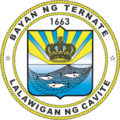Top Qs
Timeline
Chat
Perspective
Ternate, Cavite
Municipality in Cavite, Philippines From Wikipedia, the free encyclopedia
Remove ads
Ternate, officially the Municipality of Ternate (Filipino: Bayan ng Ternate and Chavacano: Municipalidad de Ternate), is a municipality in the province of Cavite, Philippines. According to the 2020 census, it has a population of 24,653 people.[5]
Formerly known as Bahra, the municipality is named after Ternate island of Indonesia where migrants from then Dutch East Indies originated.
Ternate is 47 kilometres (29 mi) from Imus and 57 kilometres (35 mi) from Manila.
Remove ads
Etymology
The town is named after the Indonesian island of Ternate, which was the homeland of settlers in the region in the late 1600s (as refugees from the Moluccas). The town was also known as Barra or Bahra (from Barra de Maragondón) in Chavacano. Prior to the arrival of migrants, the area was known as Wawa by the native Tagalogs, from the Tagalog wawa ("river mouth" or "river delta").[6]
History
Summarize
Perspective
The Merdicas (also spelled Mardicas or Mardikas) were Catholic natives of the islands of Ternate and Tidore of the Moluccas, converted by Jesuit missionaries during the Portuguese occupation of the islands. The islands were later captured by the Spanish, who vied for their control with the Dutch. In 1663, the Spanish garrison in Ternate were forced to pull out to defend Manila against an impending invasion by Koxinga on the Kingdom of Tungning in modern Taiwan, sacrificing the Moluccas to the Dutch. Two hundred families of Merdicas (of mixed Mexican-Filipino-Spanish and Papuan-Indonesian-Portuguese descent)[7] volunteered, and were resettled in a sandbar near the mouth of the Maragondon River (known as the Bahra de Maragondon) and Tanza, Cavite.[8] Among them was their ruler, Sultan Said Din Burkat, who deported to Manila together with his entourage and family and later converted to Christianity.[9]
The invasion did not occur as Koxinga fell ill and died. The Merdicas community eventually assimilated into the local population. Today, the descendants of the Merdicas continue to speak their Spanish creole (with Portuguese and Papuan influences), which came to be known as Ternateño Chabacano.[8]
Ternate was once a barrio of Maragondón, and was the first town to attain full independence from it on March 31, 1857. The agreement was signed on behalf of the residents of Ternate by Tomás de León, Félix Nigosa, Pablo de León, Florencio Nino Franco and Juan Ramos.
On October 15, 1903, Ternate was merged with Naic by virtue of Act No. 947.[10] It was later separated by virtue of Executive Order No. 96 in November 1915 but was effective only on January 1, 1916.[11]
On March 3, 1992, Mayor Octavio Velasco, along with his two bodyguards and the town chief of police Felipe Enero, were assassinated in front of the municipal hall by five unknown gunmen, alleged to be bodyguards of then-Cavite Representative Jorge Núñez.[12][13] As of March 1994, the assassins were still at large.[14]
Remove ads
Geography
Summarize
Perspective
Barangays
Ternate is politically subdivided into 10 barangays, as indicated in the matrix below. [15] Each barangay consists of puroks and some have sitios.
Currently, there are 3 barangays which are classified as urban.
Climate
Remove ads
Demographics
Summarize
Perspective
In the 2020 census, the population of Ternate, Cavite, was 24,653 people,[23] with a density of 410 inhabitants per square kilometre or 1,100 inhabitants per square mile.
Language
In addition to Tagalog, the community continue to use one of several Spanish-based creole varieties found in the Philippines, collectively known as Chabacano (Ternateño–Chavacano); locals, however, call this vernacular simply as Bahra.
Religion
Most Ternateños are Catholics, with the majority belonging to the Catholic Church, and the rest subscribing to other Christian denominations.
- Members Church of God International (MCGI)[24]
- Philippine Independent Church (Aglipayan Church)
- Iglesia ni Cristo
- United Church of Christ in the Philippines
- Jehovah's Witnesses
- The Church of Jesus Christ of Latter-day Saints
- Assemblies of God
- Church of Alpha Omega Christian Ministries Inc.
A number of residents also profess Islam, belonging to the Sunni branch predominant in the country.
Remove ads
Economy
Poverty incidence of Ternate
10
20
30
40
2000
33.39 2003
18.35 2006
12.00 2009
16.47 2012
9.03 2015
15.15 2018
11.42 2021
5.56 Source: Philippine Statistics Authority[25][26][27][28][29][30][31][32] |
Government
Elected officials
The following are the elected officials of the town elected last May 09, 2022 which serves until 2025:
Remove ads
References
External links
Wikiwand - on
Seamless Wikipedia browsing. On steroids.
Remove ads







